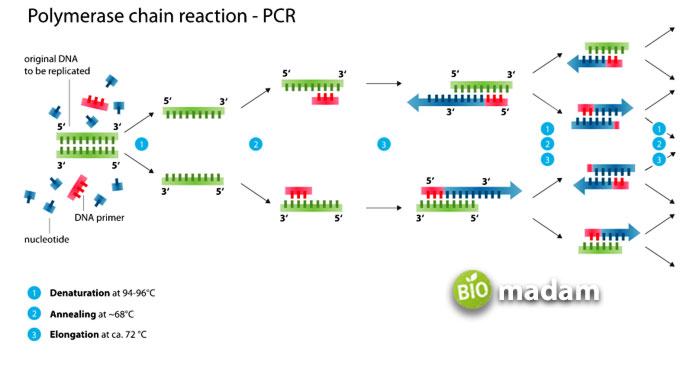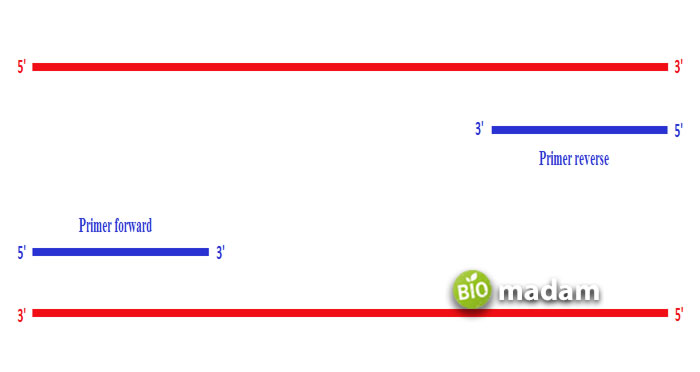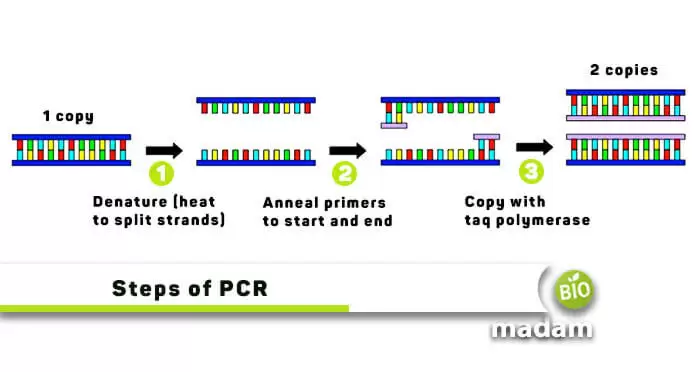Molecular biology has advanced to an extent that latest procedures like recombinant DNA technology and PCR are introduced. PCR – Polymerase Chain Reaction is the most commonly used process that involves the replication of DNA. It is one of the fastest techniques that form millions of copies of a region of DNA (genetic material). The susceptible PCR approach utilizes primers and Taq polymerases, where gel electrophoresis helps to visualize DNA products. Furthermore, special oligonucleotides are used that amplify the specific genome of an organism. It gives logarithmic amplification of short DNA sequences with long double-stranded DNA.
Nowadays, we employ various types of PCRs, such as nested polymerase chain reaction, real-time PCR, and rtPCR to magnify particular genomes. Another name for Real-time PCR is qPCR which determines the number of PCR products. A nested Polymerase chain reaction is designed to improve the sensitivity and specificity of the reaction, where it uses two types of primers. Besides, one can also generate cDNA from an RNA by the reverse transcriptase-polymerase chain reaction mostly for miRNAs.
What is a Polymerase Chain Reaction?
The chain reaction is an in-vitro technique that is held in a test tube, and not within the organisms. It involves making multiple copies of DNA from plants, animals, or humans. PCR puts several laboratory techniques in use to make hundreds and thousands of copies of DNA. One such is the CTAB technique which works to extract DNA from plants and animals.

PCR helps you amplify any targeted gene from a cell. Moreover, professionals use it in forensic sciences, especially to detect crime scenes, which is a genetic marker by forensic scientists to match crime-scene DNAs.
Where Do We Use Polymerase Chain Reaction?
It is a vast technology used in multiple areas of medicine and biology, including molecular biology research, medical diagnostics, and even a few types of ecology. PCR processes the initial stages of DNA for its sequencing. Moreover, it works to identify a gene’s absence or presence to further fight infectious pathogens. Another use of PCR is to generate DNA forensic profiles from minute DNA samples.
Principle of PCR
The movement of the charged molecules in PCR is due to the electric field, where the equation used is:
V = Eq/f
- E = Electric Field
- Q = the net charge on the molecules
- F = Friction Coefficient
- V = Velocity of a Molecule
From the above formula, the velocity is directly dependent on the electric field and inversely on the friction coefficient, where the movement of charged molecules depends on q/f. The applied voltage, represented by E, remains constant during electrophoresis. All in all, this principle helps DNA move and separate itself according to its size. These DNA fragments of the same length form a band on the gel which is seen when the gel is stained through ethidium bromide and checked under UV light. After a thorough examination, the right results appear just like the given diagram.
You can see different bands formed, such as 12,00 bp, 1000 bp, 900 bp, 800 bp, 700 bp, 600 bp, 500 bp, 400 bp, 300 bp, 200 bp, and 100 bp.
Working of PCR
The PCR is a cyclic process, a method of in-vitro synthesis of a specific DNA sequence. This technique involves high heat and maximum pH to disrupt double-stranded DNA and convert it to a single strand. This single strand serves as a template, and by using polymerase enzyme, generates double-strand DNA. Most polymerases require short regions of double-strand nucleic acid for the initiation of synthesis. Let’s move toward the steps involved in PCR.
Different Steps of PCR
The essential ingredients required in PCR are primers, Taq polymerases, template DNA, and nucleotide. We take these elements in different tubes, along with co-factors needed by enzymes, and use them in repeated cycles of heating and cooling. Thus, allowing the synthesis of DNA. The key steps involved in PCR are:
Denaturation
It is necessary to raise the temperature to separate the double strands. Denaturation provides a single-stranded template for the next step where the temperature remains around 94 -98°C
Annealing
Cool the reaction so the primers can bind to their complementary sequences on the single-stranded template. DNA temperature should be kept at 37-60°C.
Extension
As the name indicates, this step helps the Taq polymerase in increasing the reaction temperature. Thus, helping to make new DNA strands at 72-degree Celsius or 161.6-degree Fahrenheit.
When one copy is formed from a DNA, it is used as a template for the next copies and the circle goes on. It means, the PCR depends on the length of DNA that has to be copied, which continues repeating itself accordingly for 20 to 40 minutes. The entire process can take up to a few hours or might be less than an hour by using different high-speed equipment. If the procedure goes well, you can generate thousands of new copies of the specified DNA. This pattern of exponential growth is shown in the image below. The Gel Electrophoresis technique is used to visualize the results of PCR.
After several rounds, about 40 rounds of amplification, the PCR product is examined on gel electrophoresis and detected by using ethidium bromide.
What is Taq Polymerase?
Taq Polymerase is a heat-stable recombinant DNA enzyme, isolated from a thermally resistant bacterium (Thermus aquaticus) and was named after it. This enzyme efficiently helps DNA synthesize and amplify its new strands through PCR. The thermostable enzyme can keep on working at higher temperatures (70 degrees) where even E.coli and human DNA stop functioning, so it’s perfect to use in PCR.
What are PCR Primers?
DNA primers are the main requirements by Taq polymerases that further use them to amplify the portions of DNA. These are the short sequences of nucleotides designed to flank the target region, which must be copied. Their base pairs are complementary to the template and the sequence is opposite to the strand. A PCR technique uses two primers.

One primer is complementary to the negative strand, and the second is complementary to the positive strand in the presence of dNTP and DNA polymerase. Hence synthesizing the complementary sequences. After this, the experimenters can still use the same primers again to make other copies, leading to logarithmic amplification.
Template DNA
As we have discussed before, a DNA template uses two primers with different strands as 5′ 3′ and 3′ 5′
Primer 1 – 5′ 3′
Primer 2 – 3′ 5′
The polymerases can extend these primers, bound to the template, so the selected region of DNA gets copied.
Conclusion
The polymerase chain reaction has proved to be one of the best techniques to get multiple DNA copies. As this genetic material is microscopic, so the copies are clearly observed under a compound microscope. PCR was initiated earlier with other biological advancements but still needs further improvements. As it’s an important tool, it is being tested in scientific laboratories, producing enough copies of DNA sequences to see or manipulate that region of DNA.

Hello, I would like to introduce myself to you! I am Chelsea Rogers, an experienced blog writer for science articles, holding an MPhil degree. My enthusiasm to grab the best knowledge, let it relate to botany, zoology, or any other science branch. Read my articles & let me wait for your words s in the comment section.

